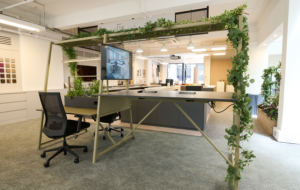
words Justin Mcguirk
“Will you take a lie detector test?” Everybody loved the idea, before reeling off a list of elaborate excuses and sudden travel plans. But five brave souls submitted themselves to our interrogation. The question is, did they actually lie to us, or did they just squirm about more than usual?
Everybody lies a little. Diplomacy, politeness, waffle – they’re all forms of half-truth, which means that we are all skilled interpreters of bullshit. But this time we wanted to take the interview to a more forensic level, where the risks are higher, and there was some threat of exposing people or embarrassing them. What would it be like to conduct an interview where the subject knows, or at least fears, that a lie would set the sensors off? Was this a sure-fire way to get to the truth? One giant leap for the bionic journalist?
We summoned the interviewees to an anonymous office in Imperial College and sat them down in front of a microphone connected to a laptop. There was no twitching polygraph needle. Instead, we used a commercial software called Truster, which was designed in Israel but registered through an American company called Mil Spec Industries (whose website boasts of clients including “governments and armies”). It works by measuring fluctuations in the voice. The user guide explains it like this: “When a person lies, the amount of blood in the vocal cords drops as a result of stress. An involuntary interference of the nerves causes the vocal cords to produce a distorted sound wave.”
However, the software interface doesn’t flash “Lie” whenever it detects stress. It produces an analysis of the subject’s speech with a range of readings that ascends in this order: Truth, Truth/Excitement, High Stress, Extreme Excitement, Subject is not sure, Inaccuracy, False Statement. So it accommodates a spectrum of emotional states before it concludes that someone is actually lying. There is also a reading, by the way, for Outsmart, but no one we tested scored any points there, either because none of them is a budding Richard Nixon or because the manufacturers of Truster don’t want you to think that it’s possible to get away with lying to their product.
Naturally, we had our doubts about just how effective Truster is. Despite the FBI requiring all employees to take a lie detector test before joining the bureau, polygraph results are inadmissible as evidence in court. Scientists have spent years debunking them, and many believe they’re about as reliable as a horoscope.
In some ways, however, it’s of little importance whether the software works or not. The very idea of a lie detector test scanning the subjects’ speech ought to make them answer the questions differently. The promotion from interview to interrogation makes for a less casual atmosphere – and there is no easier lie than a casual lie. So, in fact, we might actually have reduced the chances of catching people out. Because where they might have lied to us in an ordinary interview, perhaps now they would be very careful not to.
The first to take the hot seat was the director of London’s Design Museum, Deyan Sudjic. He certainly gave the air of taking the interrogation seriously – a museum director, after all, has more to lose from a situation like this than a designer. He proceeded cautiously, answering with what sounded like honesty. Where necessary he sidestepped questions with the grace of a politician, and glided along with the measured enunciation of a Machiavellian radio presenter. His monotone had the truth graph scarcely twitching – it was masterful. By contrast, my voice had the machine screaming “high stress” and “inaccuracy”. Sudjic, you see, had only agreed to take the test on the condition that he could interrogate me back, and was soon probing my sense of self-worth as an editor (you can see the results on iconeye.com).
Moritz Waldemeyer managed to out-flatline Sudjic, not just with his deep drone but with his studiously diplomatic answers. Yves Béhar spotted straight away the potential to be quoted disadvantageously at some future date, and was careful not to over-sell the green credentials of his new electric motorbike. Daniel Eatock was the only one who tried to outwit the software. With Julia Lohmann I decided to really put the machine through its paces. As a control question, I asked her five times how tall she was and she gave me a different answer each time. Only when she got to 7m 93cm did the software respond “inaccurate”.
One thing about a lie detector test: you can’t make people talk. One thing about a lie detector test: you can’t make people talk. Unless you are a trained specialist, that is. There are, in fact, freelance lie detector professionals whom you can hire for the day to interrogate your subjects. They’re insanely expensive and, interestingly, extremely busy. Next time I’ll hire one and have him wear a black hood.
Justin McGuirk What’s your name?
Deyan Sudjic My name is Deyan Sudjic and I left the house with no breakfast this morning. > Truth
JM What do you do?
DS I am the director of the Design Museum in London. > Truth
JM How old are you?
DS I am 56 years old. > Truth
JM Are you nervous?
DS Yes, I do respond to situations when I am put on the spot with a certain amount of anxiety. > Truth/Excitement
JM What do you think of icon?
DS Icon is an unmissable magazine, which reminds me very much of Blueprint, when I started it many years ago. I suppose I see in icon a generational shift which is both interesting and, as I get older, disturbing. > Truth
JM You curate exhibitions and you write books. Do you read your own reviews?
DS Absolutely, but I always try and remember that line by somebody quite famous who wrote back to a reviewer saying: I am in the smallest room in the house and I have your review in front of me. It will soon be behind me. > Truth
JM Did you read my review of your book The Language of Things?
DS I did read your review, which some people seemed to think was not very positive, but I thought it was rather positive, so thank you. > Truth/Excitement
JM So it didn’t irritate you?
DS No. There’s nothing more irritating than being ignored. > Truth/High stress
JM Would you like to be on television?
DS Not fantastically, because I’m vain enough to worry about how I would look on television. I prefer radio. > Truth
JM Who’s the most difficult architect or designer you’ve done an exhibition on?
DS People always think that Zaha Hadid is a difficult person but it wasn’t my experience at all. When I was doing the Venice architecture biennale I remember being extremely annoyed with Massimiliano Fuksas’ wife Doriana, who, after we very elegantly installed the labelling system, insisted on using a magic marker to change the credits on theirs, and I remember being rather upset about Peter Eisenman’s promise to deliver a vast model of his project in Galicia, which in the end turned out to be a rather small model. > Truth/High stress
JM Who’s the most overrated architect or designer?
DS When I was editing Blueprint I would have found that a very easy question to answer. Now I suppose I try to take a longer view of people’s careers. It sounds like I’m trying not to answer this question … > Subject not sure
JM What does the future of the design museum look like?
DS Astonishingly, in what looks like a catastrophically bad moment, we’re on the
verge of doing something really good. > Truth/Excitement
JM Who should win the Designs of the Year?
DS An easy answer would be the Obama poster. A worthy answer would be Ideo’s tricycle that purifies water. I like Terence Woodgate’s astonishing endless carbon fibre table, although it’s too big to get in my house. > Truth
JM Do you think the 2012 Olympics will be a success?
DS How do you define success? Will it be worth the money? I find it hard to believe that it will. On the other hand, if it wasn’t for the 2012 Olympics, the future of Britain and London would be even bleaker. > Truth
Portrait by Maja Flink















